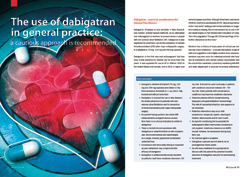
This question raises several issues and is likely to be a common scenario in managing patients in primary care who
require antithrombotic treatment.
Firstly, it is unclear why the patient is taking both aspirin and warfarin as it appears that they are both being
given for the same indication. It is also unclear if the patient has had a previous cardiovascular event, but we can
presume that the medicines are being given for primary stroke prevention. We also presume that the AF is non-valvular
and permanent.
- Anticoagulation with warfarin or dabigatran is indicated for the primary prevention of stroke in people with AF,
who have a moderate to high risk of stroke
- Aspirin may be considered for people with AF who have a low risk of stroke or those who are unsuitable for anticoagulation,
e.g. patients with severe liver disease, recent history of gastrointestinal bleeding
- Aspirin and warfarin or dabigatran in combination for the primary prevention of stroke is not recommended
The risk of stroke in people with AF can be calculated using assessment tools such as CHADS2, CHA2DS2-VASc
and HAS-BLED (see here for these tools). If the CHADS2 score
is ≥ 2, the patient should be anticoagulated. If the CHADS2 score is less than 2, CHA2DS2-VASc
can be used to further evaluate risk. Anticoagulation is recommended for people with a CHA2DS2-VASc
score ≥ 1.
HAS-BLED can be used to calculate the risk of bleeding when considering anticoagulant use. A score of ≥ 3 indicates
a patient who may be at high risk of bleeding complications. This is of particular significance in the present scenario
as the patient lives in a rural area, therefore access to medical services is likely to be delayed if a bleeding event
did occur.
Therefore the choices needed to be made for this patient are:
- What is her stroke risk?
- Should she be on aspirin or an anticoagulant? (or possibly even no treatment?)
- If an anticoagulant is the appropriate choice, should this be warfarin or dabigatran?
Factors to consider when choosing between warfarin and dabigatran for this patient (with non-valvular AF and already
on warfarin) include:
| Stay on warfarin |
Change to dabigatran |
| Stable INR |
Difficult to control INR |
| Comfortable with the need for monitoring |
Monitoring poses difficulties |
| Taking medicines that may interact with dabigatran, e.g. verapamil or amiodarone for AF |
Taking medicines which interact with warfarin |
| Creatinine clearance < 30 mL/min |
|
| Unlikely to be compliant with twice daily dosing |
|
| Require compliance packaging e.g. blister pack or tray (although new dabigatran packaging is in development) |
|
Other factors such as weight < 60 kg, age > 80 years, and creatinine clearance 30–50 mL/min, which means that dabigatran
must be used with caution, may help with decision making.
Therefore in summary, it appears that this patient is unlikely to require both aspirin and warfarin, so at least one
medicine should be stopped, depending on risk of stroke. If the patient is stable and able to attend for INR monitoring,
consideration should be given to remaining on warfarin, especially given that a bleeding event carries more risk to
a patient in a rural area with dabigatran, in which there is no antidote able to be carried by the closest medical professional
(such as vitamin K for warfarin). If the decision is made to swap to dabigatran, ensure that INR is less than 2, check
creatinine clearance and ensure that the correct dose is given for the patients age (i.e. < 80 years: 150 mg, twice
daily, ≥ 80 years: 110 mg, twice daily).